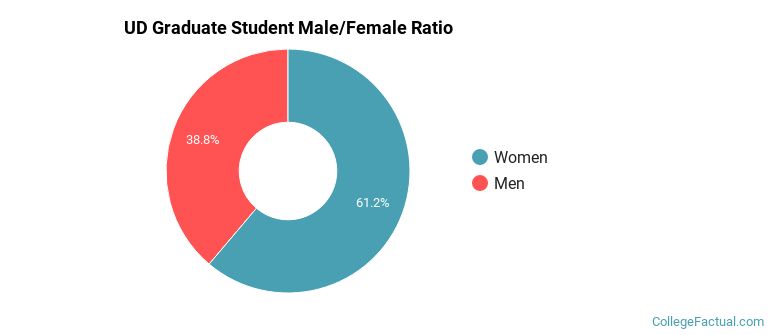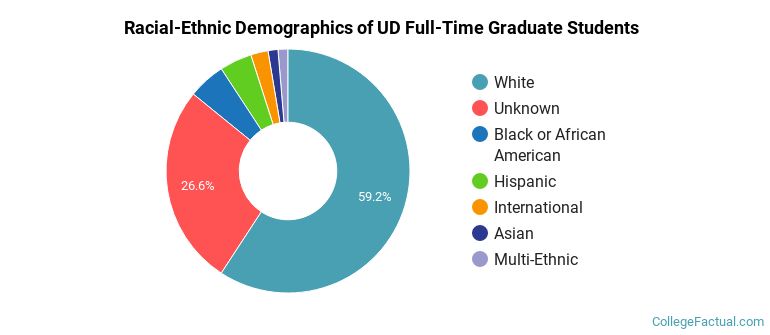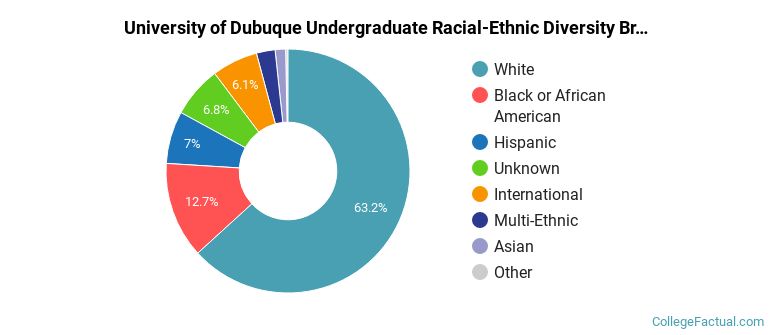 by our College Data Analytics Team
by our College Data Analytics TeamUD total enrollment is approximately 2,180 students. 1,456 are undergraduates and 334 are graduate students.
Male/Female Breakdown of Undergraduates
The full-time UD undergraduate population is made up of 39% women, and 61% men.

For the gender breakdown for all students, go here.
UD Racial/Ethnic Breakdown of Undergraduates

| Race/Ethnicity | Number |
|---|---|
| White | 886 |
| Black or African American | 239 |
| Hispanic | 127 |
| International | 84 |
| Multi-Ethnic | 48 |
| Unknown | 42 |
| Asian | 18 |
| Native Hawaiian or Pacific Islander | 7 |
See racial/ethnic breakdown for all students.
Male/Female Breakdown of Graduate Students
About 56% of full-time grad students are women, and 44% men.

For the gender breakdown for all students, go here.
UD Racial-Ethnic Breakdown of Graduate Students

| Race/Ethnicity | Number |
|---|---|
| White | 201 |
| Unknown | 82 |
| Black or African American | 24 |
| Hispanic | 13 |
| International | 9 |
| Asian | 3 |
| Native Hawaiian or Pacific Islander | 1 |
| Multi-Ethnic | 1 |
See racial/ethnic breakdown for all students.

| Race/Ethnicity | Number |
|---|---|
| White | 1,363 |
| Black or African American | 300 |
| Hispanic | 169 |
| Unknown | 144 |
| International | 104 |
| Multi-Ethnic | 59 |
| Asian | 25 |
| Native Hawaiian or Pacific Islander | 9 |

There are approximately 983 female students and 1,197 male students at UD.
UD ranks 282 out of 2,183 when it comes to geographic diversity.
73.85% of UD students come from out of state, and 2.95% come from out of the country.

The undergraduate student body is split among 29 states (may include Washington D.C.). Click on the map for more detail.

| State | Amount |
|---|---|
| Illinois | 173 |
| Iowa | 108 |
| Wisconsin | 59 |
| California | 9 |
| Texas | 8 |
Students from 31 countries are represented at this school, with the majority of the international students coming from Saudi Arabia, China, and Taiwan.
Learn more about international students at UD.
A traditional college student is defined as being between the ages of 18-21. At UD, 54.90% of students fall into that category, compared to the national average of 60%.

| Student Age Group | Amount |
|---|---|
| 18-19 | 712 |
| 20-21 | 587 |
| 22-24 | 366 |
| 35 and over | 325 |
| 25-29 | 230 |
| 30-34 | 124 |
| Under 18 | 0 |
Footnotes
*The racial-ethnic minorities count is calculated by taking the total number of students and subtracting white students, international students, and students whose race/ethnicity was unknown. This number is then divided by the total number of students at the school to obtain the racial-ethnic minorities percentage.
References
Department of Homeland Security Citizenship and Immigration Services
Image Credit: By Rolfmueller under License
Read College Factual's Diversity Ranking Methodology.